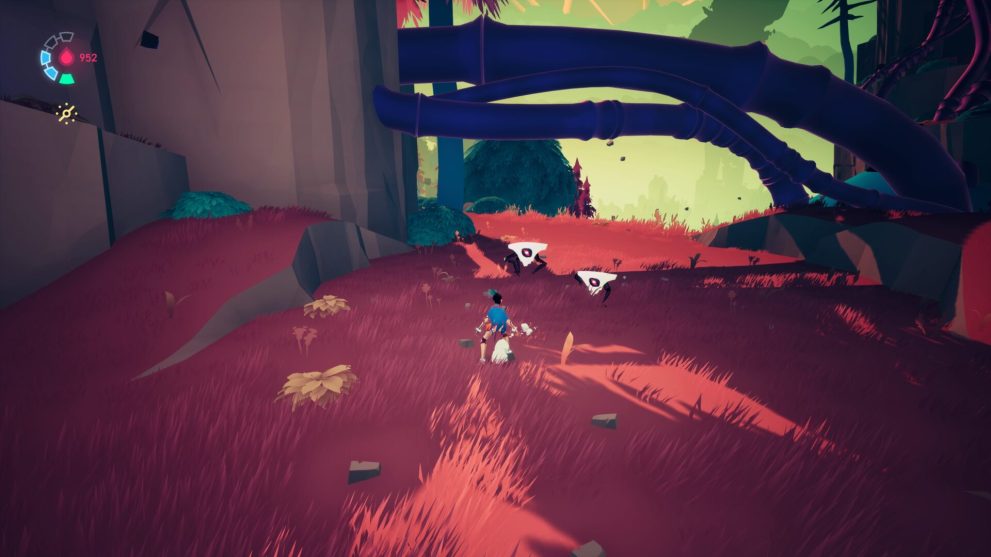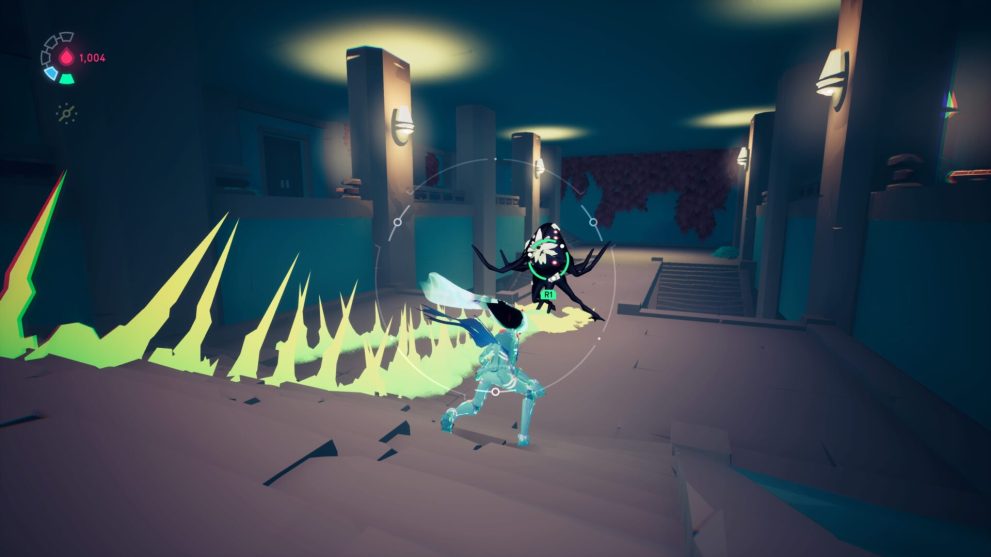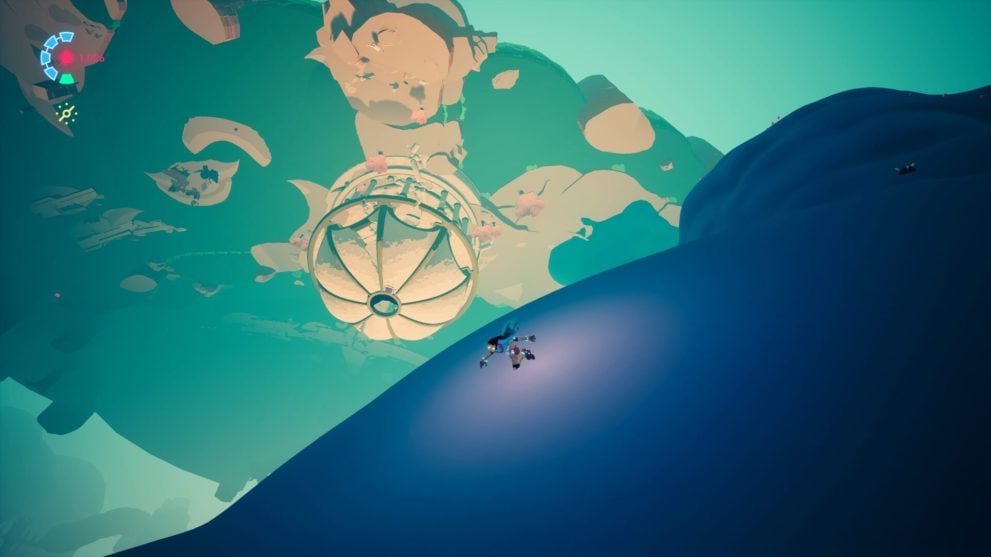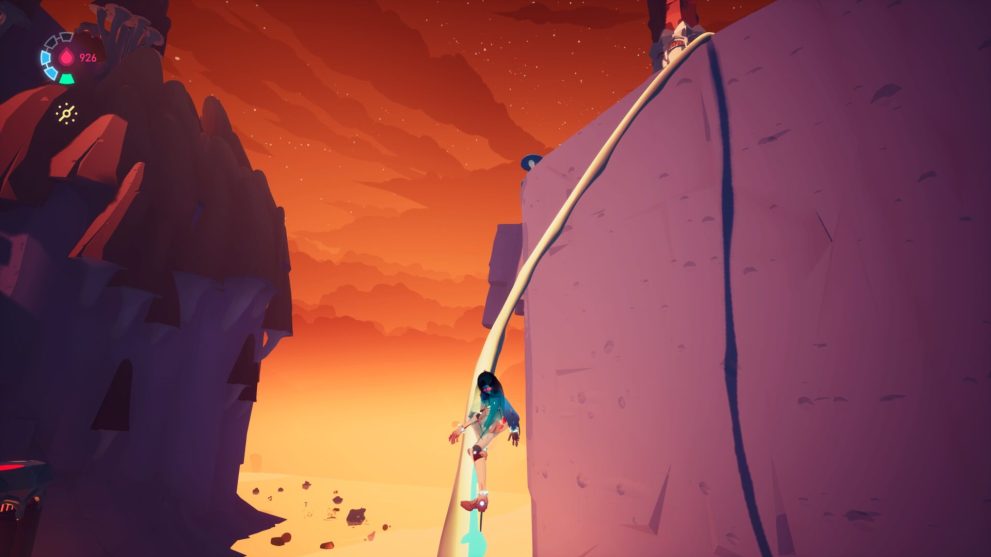2021 has been filled with tons of incredible indie games, like Loop Hero, Cyber Shadow, Inscryption, and so many more. And there is one more banger to fill out the calendar from the team at Heart Machine (Hyper Light Drifter). Solar Ash is a colorful action-adventure experience that sends you speed skating around multiple environments with all kinds of gravity-bending platforming mechanics baked in.
It is a game about going fast and mastering movement, and it tells an important story about cobbling together something worthwhile when life gives you nothing but hopeless situations.
From the start of Solar Ash, you are thrown into a strange and hostile world known as the Ultrvoid. You navigate this black hole that is threatening to destroy your home planet as the Voidrunner, Rei. She is a part of a group (the Voidrunners) that took it upon themselves to save their home planet when the governments of their world could not come to a consensus on how to prevent the world from falling into darkness.
You will also encounter a character known as Echo after each boss fight. She plays an important role in progressing the story, but that is as far as we will go to avoid spoilers. But we have no problem saying that Fryda Wolff’s performances as Echo and Rei are fantastic. Playing two different and highly important characters is no easy task, and she pulled it off flawlessly.
Voice acting is a bit of a new field for a Heart Machine game (Hyper Light Drifter had no voice acting), but every member of the cast delivered good performances in the audio logs that you can pick up across the game world.
Throughout the Ultrvoid, you will find these Voidrunner caches that contain audio recordings from your fellow black hole spelunkers. These logs help you learn more about the individual characters as well as build out the worlds of the Ultravoid and your home planet.

Fortunately, these hidden audio logs are not crucial to understanding the basics of the story. Still, they are all relatively easy to find since each hidden cache has an arrow pointing to its location left behind by a fellow Voidrunner.
However, you should absolutely still search out each of these caches even if the additional backstory is not something that you care for. In a fairly smart move to get the players who are only into the gameplay, these caches also contain parts of unlockable suits. Collect all of the caches in an area and you will unlock a new suit that will let you do more damage to enemies, get more plasma (Solar Ash’s currency), or even use your boost more often.
Even though the unlockable suits are not required to make it through any part of the game, they give the player a way to customize Rei to better fit their playstyle. For example, I used Ghozam’s suit which doubled my attack because it let me skate up to enemies at full speed, take them out quickly, and keep on moving without slowing down much.
And that is part of what makes the gameplay so great in Solar Ash. You have everything you need to complete the game right from the start. The only thing that needs to be upgraded is your ability to master the controls. Fortunately, simply moving Rei around the Ultravoid is one of the best parts of the game.
Rei moves slowly around the world if you just use the left stick. Add in the left trigger and you will start skating around the clouds that make up much of the Ultravoid’s ground. You can also boost by hitting the other trigger button to make long jumps or to quickly evade an enemy attack. Or you can always attack the enemies. Rei also has a double jump to get to high platforms.
The major focus in Solar Ash is clearly the movement. Almost everything about it from grinding rails to dashing feels extremely fluid and natural. And if that is not enough, then there is also a gravity mechanic that is reminiscent of Super Mario Galaxy. This leads to some mind-bending visuals and incredibly wild platforming.

The speed at which you can move through each area while doing cool-looking movement only serves as a testament to the expert-level design in Solar Ash. It simply does not feel like a studio that has put out its first 3D game. Jumping from grind rails and using the Timeslip and grapple to pull yourself towards a ledge, then continuing to skate across the ground looks and feels absolutely incredible.
The only blemish when it comes to the movement is the feeling of turning while skating. You may feel like going as fast as you can at all times since the game pushes you in that direction with wide-open areas. But sometimes it feels like you’re trying to turn a boat on a dime while skating.
You can remedy this by slowing down and turning. It makes sense to have a wider turning radius while moving so quickly, but it’s a bit too dramatic. Letting the player move so abruptly in a different direction does not work either. That’s a big problem that makes certain speed-focused 3D platformers feel uncontrollable. It would be nice to maintain more momentum while changing directions.
But where the movement shines even brighter is in the game’s combat. There are no upgrades or different weapons to equip. All you have is what Rei is equipped with from the start of the game. That means you need to get creative with the ways that you approach enemies. Sure, you can run up to them and start slashing. You are not going to last long that way.
Or you can boost to dodge an enemy attack, then use the Timeslip to slow down time and throw out your grapple to pull yourself towards an enemy and deal the killing blows. Despite there only being five enemy types in Solar Ash, they are all well-placed to always present a challenge. For example, I found a cache that looked like it was an easy pick-up, but as I got closer an enemy started tracking my movements and fired a beam of energy at Rei.
Each enemy encounter makes you think about how to use your movement options to evade hits and follow up with attacks. But the boss (Remnant) fights are what truly test your platforming skills, effective use of your Timeslip, and your overall mastery of Solar Ash’s controls.

I will admit it, I am a sucker for giant boss fights. There is something magical about that initial awe of seeing a giant Remnant for the first time and wondering how the heck you will be able to beat something so massive. And then the action of toppling the behemoths makes you feel like you are capable of doing anything in that game world. Until you reach the next Remnant fight.
What’s more, each of these boss fights uses the gravity mechanic to make sure that your feet stay firmly on the boss. Each Remnant battle makes for increasingly more stunning screenshots. But you can not just stick around to take in the views. These battles truly test your speed and accuracy. You need to move from one point to another before the Remnant reaches too high of a temperature and kills Rei.
The only negative part truly is the lead-up to each Remnant battle. Every area in the Ultravoid has a set number of anomalies that you need to clear. Each time you clear one, it shows a short cutscene of the upcoming Remnant’s eye opening. Once all of their eyes are open, then you can jump into the boss battle. It just starts to get a bit too repetitious over time.
Some of the anomalies present environmental puzzles that make you take a step back and think about the coolest-looking way to clear them. But for the most part, a lot of them just become tasks to check off a figurative list. Despite the repetition, the overall fun of the movement in Solar Ash manages to at least make the recurrence of these segments slightly enjoyable.
Once you finally take out a boss, you are treated to an explosion of colors that is emblematic of the game’s loud color scheme. The overall color palette definitely has shades of Hyper Light Drifter. The neon blues and pinks on Rei’s original suit pop right off the screen against the more pastel-shaded backgrounds. This art style is consistent throughout the game’s multiple areas and it makes Solar Ash a joy just to look at.
On top of that, the Solar Ash has a fantastic soundtrack. Even if it is not something you might throw on to sit back and listen to, it still fits the game world perfectly. As you are exploring the Ultravoid it is a more peaceful, almost ambient sound, but the urgency and tension quickly pick up as soon as you approach a group of enemies or an anomaly. And the Remnant fight music gets you hyped up to take on each giant beast.

Solar Ash is nothing short of a beautiful accomplishment that puts the finishing touches on a stellar year of indies across multiple platforms and genres. The art, music, gameplay, and story all coalesce into a fantastic action-adventure game that is one of the best indie releases of the year.
Solar Ash is not without its faults. The small ensemble of enemies and the repetition are the most obvious. But as a whole, the positives decisively outshine the handful of negatives.
If you have a few hours to spend and want to play something that is unlike anything else this year, then Solar Ash is absolutely worth checking out. Anyone who is a fan of the action-adventure genre will no doubt enjoy this memorable experience.
Pros
Cons
Tight turns reduce speed too much
Small ensemble of enemies
